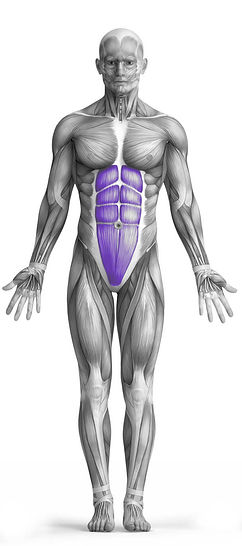Bear Crawl 101 Video Tutorial
0

Exercise Synopsis
Target Muscle Group
Abs
Execution
Compound
Force Type
Core
Required Equipment
Bodyweight
Fitness Level
Intermediate
Variations
None
Alternatives
Timer
Hour
Minute
Second
Stopwatch
00:00:00:00
Overview
The Bear Crawl is a dynamic bodyweight exercise that primarily targets the abdominal muscles while also engaging secondary muscle groups such as the obliques, forearms, and shoulders. This exercise requires no equipment other than one's own body weight. To perform a Bear Crawl, start in a tabletop position with hands under shoulders and knees under hips. Lift the knees slightly off the ground, keeping the back flat and core engaged. Move forward by crawling on hands and feet in a coordinated, diagonal pattern, maintaining stability and balance throughout. The Bear Crawl not only strengthens the core muscles essential for stability and posture but also improves coordination and overall body control.
How to Perform
Begin by assuming a table-top position on the floor, with hands positioned directly under shoulders and knees under hips. Ensure your feet are hip-width apart for stability.
Press firmly into the floor with your palms to activate your core muscles, lifting your knees approximately two inches off the ground to initiate the crawl.
Maintain a flat back and engage your core throughout the movement to stabilize your body.
Move forward with a controlled motion by stepping your right arm and left leg forward two inches simultaneously, followed by your left arm and right leg in the same manner. Keep your hips level with the floor at all times to maximize core engagement.
Repeat this crawling motion, taking four steps forward in total.
After completing the forward crawl, reverse the movement by taking four controlled steps backward.
Throughout the exercise, focus on maintaining proper form and controlled movements to enhance strength, coordination, and stability.
★ Bonus: For exercises that involve external weights (such as dumbbells, barbells, or machines), the One Rep Max (1RM) calculator can help you estimate your maximum lifting capacity. Use it to track your strength progress and adjust your training for optimal results.
Tips
Begin in a table-top position with hands under shoulders and knees under hips, ensuring a stable base.
Engage your core by pressing palms firmly into the ground and lifting knees about two inches off the floor.
Keep your back flat and hips level throughout the movement to maximize core activation.
Alternate crawling forward by moving right arm and left leg simultaneously, followed by left arm and right leg.
Maintain a steady pace and controlled movement to challenge stability and coordination.
Aim to take equal steps forward and backward to balance muscle engagement.
Focus on breathing steadily to support endurance and maintain core engagement.
Avoid overarching or rounding the back to prevent strain on the spine.
Incorporate variations like lateral or diagonal crawls to challenge different muscle groups.
Use the Bear Crawl as part of a dynamic warm-up or full-body workout to enhance functional strength and agility.
How Not to Perform
Avoid arching or rounding your back during the Bear Crawl to prevent strain on the spine and maintain proper core engagement.
Do not allow your hips to sag or rise too high, as this can reduce the effectiveness of the exercise and put undue stress on the lower back.
Resist the temptation to rush through the movement; maintain a controlled pace to ensure proper muscle activation and coordination.
Refrain from holding your breath; instead, focus on breathing steadily and rhythmically to support endurance and core stability.
Avoid excessive swinging or twisting motions with your torso; keep movements stable and controlled to target the intended muscle groups effectively.
Do not allow your shoulders to hunch up towards your ears; keep them relaxed and away from your neck to prevent tension and strain.
Avoid relying solely on momentum; instead, focus on engaging the core muscles to initiate and control each movement.
Do not neglect proper hand and foot placement; ensure your hands are directly under your shoulders and your feet are hip-width apart to maintain stability and balance.
Avoid hyperextending your elbows or locking out your knees; keep joints slightly bent to reduce the risk of injury and maintain muscle engagement.
Do not push yourself to the point of exhaustion or compromise form for the sake of completing reps; prioritize quality over quantity to maximize the benefits of the exercise while minimizing the risk of injury.
Variations
Variations of fitness exercises refer to different ways of performing a specific exercise or movement to target various muscle groups, intensities, or goals. These variations aim to challenge the body differently, prevent plateaus, and cater to individuals with varying fitness levels.
Alternatives
Alternative exercises in fitness refer to different movements or activities that target similar muscle groups or serve the same training purpose as the primary exercise. These alternative exercises can be used as substitutes when the original exercise is unavailable or challenging to perform due to various reasons such as equipment limitations, injuries, or personal preferences.








